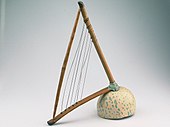Frame zither
 Liberian zither with calabash resonator. Called a "harp" by its collector; however, on a harp the "plane of the strings lies perpendicular to the resonator's surface." The strings running parallel to the gourd resonator make this a frame zither under Hornbostel-Sachs. | |
| String instrument | |
|---|---|
| Other names | belly harp |
| Classification | Plucked string instrument |
| Hornbostel–Sachs classification | 316
|
| Inventor(s) | folk instrument |
Frame zither is a class of musical instrument (subset of zither) within the Hornbostel-Sachs classification system for a type of simple chordophone (stringed instrument), in which the body of the instrument is made from a frame.[1]
Frame zithers are musical instruments in which strings are strung across an open frame.[2] They could be similar to harps and psalteries which can also have strings stretched across frames. However, in harps the strings run from the frame to a resonating table embedded into the frame on the frame's other end. Psalteries may also have a frame, but behind the strings (parallel to them) is a board, the top of a box which acts as a resonator.
Musicians may add a resonator as is done with a bow harp; they can attach or put the instrument into a calabash gourd or a ceramic pot.[3]
Under the Hornbostel-Sachs system of musical instrument classification, any frame with strings stretched across, and without a built in resonator, would count as a frame zither. In musical instrument encyclopedias, however, there are few or no examples of frame zithers except those found in Africa. Potential examples include medieval European illustrations; these however are not clear and could equally illustrate forms of harps or psalteries.[1]
Africa
Triangular
African frame zithers are made with frames of three "arms" forming a triangle, or a round frame made of wood.[3] Two of the arms are inserted into a calabash gourd base, with the base of the gourd cut away.[4] The gourd acts as a resonator.[4] The instrument is played by holding the opening in the resonator against the player's chest or stomach, with the instrument being within reach of their arms.[4][5][6]
The main known example are instruments of the Kru people of Liberia. They may also be seen in Sierra Leone and Guinea.[4]
Round
Another form of African frame zither uses a round frame or hoop, with the strings stretched across it.[3] Women of the Nuba people of Sudan make round frame-zithers, by bending a stick into a hoop, spanned 3 or four times by a single string (forming individual lengths to play).[3] The instrument is placed on top of a gourd for resonance.[3]
Recordings
- Belly Harp. Folk Music of Liberia, Folkways FE 4465 (Side ll, band 3)[7]
-
A loma belly harp, played by the Crau, Crau, Krao, Krawi, Kru, Nana peoples of West Africa.
References
- ^ a b von Hornbostel, Erich M.; Sachs, Curt (March 1961). "Classification of Musical Instruments: Translated from the Original German by Anthony Baines and Klaus P. Wachsmann". The Galpin Society Journal. 14: 20–21. doi:10.2307/842168. JSTOR 842168.
[Example:] Perhaps in medieval psalteries.
- ^ Sadie, Stanley, ed. (1984). "Frame zither". The New Grove Dictionary of Musical Instruments. p. 794. Volume 1.
- ^ a b c d e Ulrich Wegner (1984). Afrikanische Saiteninstrumente. Veröffentlichungen des Museums für Völkerkunde Berlin. Neue Folge 41. Abteilung Musikethnologie V (translation: African string instruments. Publications of the Museum for Ethnology, Berlin. New series 41, Department of Ethnic Music V. Berlin: Staatliche Museen Preußischer Kulturbesitz. pp. 76–81.
- ^ a b c d Marcuse, Sybil (1975). A Survey of Musical Instruments. New York: Harper & Row. pp. 188–189.
- ^ Liberian Educational and Cultural Materials Research Project. 1973.
- ^ Sadie, Stanley, ed. (1984). "Belly Harp". The New Grove Dictionary of Musical Instruments. p. 219. Volume 1.
- ^ Development of Materials for a One Year Course in African Music for the General Undergraduate Student: (Project in African Music). Office of Education. 1970.


